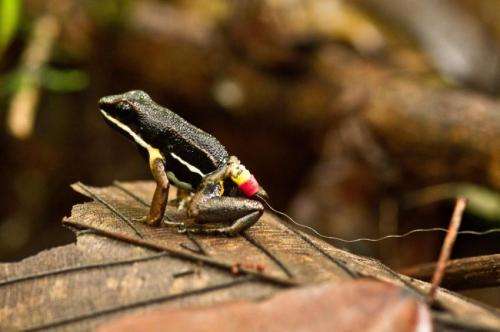Credit: Andrius Pasukonis
(Phys.org) —A quartet of researchers with the University of Vienna has found that the brilliant-thighed poison frog is able to build a mental map of its immediate surroundings and use it to navigate. The finding, the team reports in their paper published in the journal Biology Letters, suggests that such frogs have the mental ability to understand the environment in which they live.
Frogs, as we all know, lay eggs which eventually grow to become tadpoles. And tadpoles, because they have no legs, need water to survive. But the brilliant-thighed poison frog doesn't live in water, instead, it lives among leaf litter on the floor of the Amazonian rainforest. To keep their tadpoles alive, the adults carry them from puddle to puddle on their backs. Thus, the frogs need to know the location of all the puddles in their little part of world. Somehow, it seems, they build mental maps that allow them to move from one water nursery to the next without deviating.
To better understand the frogs, the researchers fitted several of them with tiny transmitters that allowed for tracking every move the volunteer frogs made. Then, they placed the frogs in different parts of the forest to see how well they did in finding their way back to where they lived. Remarkably, the researchers found that if the frogs were placed within a certain familiar range they were able to march straight back to their home without having to even pause or look around. Frogs that were placed in unfamiliar terrain on the other hand, became lost for awhile and had to work to get home. The researchers found that the range for familiar territory ranged at least up to 100 meters from where the frogs called home, though prior research has shown that such frogs typically roam in a circular area roughly 600 meters in diameter.
Interestingly, frogs are generally considered to be sedentary, which is why until now, none have been found that are able to display spatial abilities. The researchers note that the frogs, despite being poisonous, are still at risk from a variety of predators, thus, having an internal map can help reduce needless exposure.
More information: Poison frogs rely on experience to find the way home in the rainforest , Biology Letters, Published 19 November 2014. DOI: 10.1098/rsbl.2014.0642
ABSTRACT
Among vertebrates, comparable spatial learning abilities have been found in birds, mammals, turtles and fishes, but virtually nothing is known about such abilities in amphibians. Overall, amphibians are the most sedentary vertebrates, but poison frogs (Dendrobatidae) routinely shuttle tadpoles from terrestrial territories to dispersed aquatic deposition sites. We hypothesize that dendrobatid frogs rely on learning for flexible navigation. We tested the role of experience with the local cues for poison frog way-finding by (i) experimentally displacing territorial males of Allobates femoralis over several hundred metres, (ii) using a harmonic direction finder with miniature transponders to track these small frogs, and (iii) using a natural river barrier to separate the translocated frogs from any familiar landmarks. We found that homeward orientation was disrupted by the translocation to the unfamiliar area but frogs translocated over similar distances in their local area showed significant homeward orientation and returned to their territories via a direct path. We suggest that poison frogs rely on spatial learning for way-finding in their local area.
Journal information: Biology Letters
© 2014 Phys.org





















